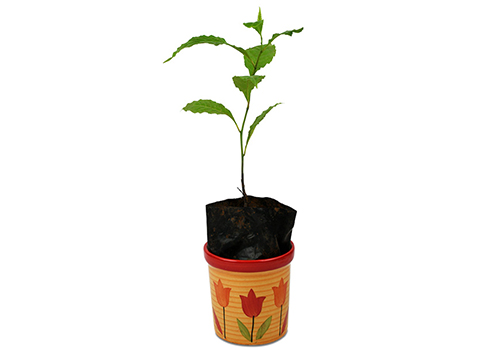ABOUT RUDRAKSHA
When we hear the word ‘Rudrakshas’, an image of the Rudraksha mala or a bracelet or loose beads is what comes to our mind quickly isn’t it? Rudrakshas are the most divine seeds which are often referred to as beads. The Rudraksha beads hold a curative range of properties and offer a list of benefits. Rudraksha beads are highly revered in Hinduism. The word ‘Rudraksha’ literally is made by co- joining two words ‘Rudra’ meaning Lord Shiva and ‘aksha’ meaning tear drop. The Rudraksha therefore symbolises the tear drop of Lord Shiva. These powerful beads are also highly revered in Buddhism and Jainism. This divine bead has a rich history and has its mention in the ancient Holy Scriptures.
CLICK HERE TO BUY NEPAL RUDRAKSHA PLANT
ABOUT RUDRAKSHA PLANT
.jpg)
The Rudraksha tree is an evergreen tree which has broad leaves. Botanically the Rudraksha tree is referred to as the Elaeocarpus ganitrus. There are 300 species of Elaeocarpus ganitrus trees all over the world out of which 35 species of this evergreen tree are found in India. These trees produce the Rudraksha fruit from which the Rudraksha beads are sourced. The approximate height of the Rudraksha trees range between 50 ft. up to 200 ft. These trees are usually found in South-East Asia, Himalayas, Nepal and Indonesia. Even you can plant this divine tree in your garden or in an open space near your house.
HOW TO GROW RUDRAKSHA TREE

Yes, you read it right! You can plant a Rudraksha sapling or the Rudraksha beads in your garden or in an open space near your house by simply keeping the following things in mind. Note, the most favourable time to plant the Rudraksha tree is between September to October. The climate of India is harsh and sometimes gets extreme hence, it is recommended that you plant the Rudraksha seeds or the Rudraksha saplings in a shadow of either another surrounding trees or a shade which will protect the plant from direct exposure to Sun especially during summers. Ensure that the temperature of the place where you are planning to plant the Rudraksha saplings or the Rudraksha seeds remain below 35 degree centigrade. Hence, it is advisable to plant the saplings below other trees and in a plot which has sufficient place. Once, the saplings or the seeds are planted make sure that you water it once in a day without fail during winters and twice in a day during summers. Remember, to keep the soil moist by watering it at regular intervals, avoid water logging. the Rudraksha plant takes time to grow or sprout from a seed, so you need to be patient after planting the seed. The seed takes many weeks to germinate and sprout. Once the plant starts growing, it takes about three to four years to bear the fruits. The tree starts bearing white coloured flowers which have fringed petals. These Rudraksha flowers later mature into drupaceous fruit which resembles to olives. When these fruits ripe they look similar to Blueberries. It takes about 15 to 16 long years for it to grow into a fully mature tree.
A GUIDE TO RUDRAKSHA PLANT
.jpg)
Rudraksha beads contain 50.031 % carbon, 0.95% nitrogen, 17.897% hydrogen and 30.53% oxygen. The trunks of the Rudraksha trees are cylindrical in shape and its bark is greyish white in colour. The trunk of the tree has a rough texture. From a single Rudraksha tree Rudraksha beads of different mukhis are acquired at the same time. Rudraksha beads of higher Mukhis or faces are very rarely found, whereas the Five Mukhi Rudraksha is the most commonly found Rudraksha bead. These beads grow in seasonal pattern around mid- August to mid- October every year.
HOW IS RUDRAKSHA ACQUIRED FROM A FRUIT?
.jpg)
Once the Rudraksha tree matures it starts bearing small flowers, these flowers after a period of time become fruits which are green in colour. Once these fruits mature or ripe they turn in to bluish purplish colour which looks like blueberries. After a certain period, the Rudraksha fruit starts drying up, the purple colour of the fruit skin starts turning into blackish colour. Once the entire Rudraksha fruit turns hard and blackish in colour, it should be collected and then this fruit must be soaked in water for 12 – 15 hours in order to make the hard dried skin soft. Once the dry outer skin of the Rudraksha gets soft, it should be pealed and scrubbed, this is how the Rudraksha is acquired from inside this dried fruit.
RUDRAKSHA PLANT BENEFITS AND USES
.jpg)
- Helps to fight against diseases and improves overall health
- Helps attract positivity and wards of negativity, and evil eye
- Offers cool environment due to its evergreen nature
- Uplifts spirituality, self - confidence and offers protection
- The leaves of Rudraksha tree have anti-bacterial properties which are used in treating wounds mental disorders, epilepsy and migraine
- The outer skin of the Rudraksha fruit holds medicinal properties. Boiled fruit water can be used to treat fever, cold and cough
- The Rudraksha beads aid in meditation
- Rub the five mukhi Rudraksha on grind stone and apply this mix on the affected parts. It helps relieving pain.
- All the parts of the Rudraksha Tree are beneficial and hold medicinal properties








Raju
|May 7, 2024
I want live rudraksha plant to plant in my garden